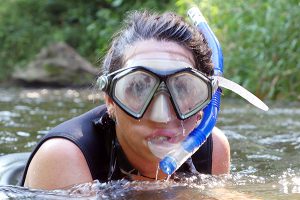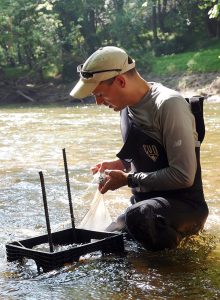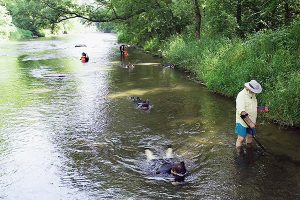Flexing Maryland Mussel: Restoring an imperiled wild species

Harvested mussels are transferred into purposefully selected areas of the Patapsco River; by Stephen Badger
Highly sensitive to habitat and landscape alterations, the most common freshwater mussel species in the state has been absent from the Patapsco River for decades.
Fortunately, collaborative efforts between the Maryland Department of Natural Resources and U.S. Fish and Wildlife Service have resulted in the return of hundreds of mussels to this scenic river, while more are being cultivated in hatcheries to further restore the native population.
Reintroductions
A common concern across North America, nearly two-thirds of the continent’s approximate 300 freshwater mussel species are in decline or worse. In Maryland alone, 14 out of 16 native species are considerd rare, threatened or endangered.
A restoration team of department biologists, water quality experts and partners has spent the past few years studying how two commonly occurring freshwater mussel species—the eastern elliptio and alewife floater—fare in captivity before they proceed to investigate how they would survive in the wild.
This past summer, they were able to relocate hundreds of wild eastern elliptio from Deer Creek in Harford County to the Patapsco in Howard County. Individual mussels have been given unique identification numbers and radio tags, then carefully placed, one-by-one, on the river bottom.
In time, it’s expected these transplants will reproduce naturally in the waterway. They’ll be joined as early as next year by a new batch of juvenile alewife floaters, currently being cultivated at the Joseph Manning Hatchery in Charles County.
| Fast facts There are 840 freshwater mussel species found worldwide. North America is home to 300 of them, 16 of which are native to Maryland. They range from 1.5-11 inches long and can weigh up to 5 pounds. They live from 8-100 years, with the oldest on record reaching 150! |
The other bivalve
When generally considering natural water filters, oysters are often top of mind. While a single adult oyster can filter as much as 50 gallons in 24 hours, a mussel can handle about 20 gallons. Unsurprisingly, the denser the population, the cleaner the water. In some streams, that can mean filtering the entire volume of water flowing through in a single day! This removal of pollutants like nitrogen and phosphorous is monumental for freshwater systems, indicating a healthy ecosystem in and beyond the water.
Unlike oysters, however, freshwater mussels have a complex reproductive cycle. Their larvae, or glochidia, must temporarily attach to fish gills or fins to grow for a few weeks before developing into juveniles. Once the glochidia reach a certain size, they detach themselves and fall to the river’s bottom, where they spend several years reaching maturity.
Mussels also require hosts during early development—usually fish. Some mussels can choose between many different fish species as a host, while others are restricted to just a few. In Maryland, migratory fish are the host for most mussel species.
The eastern elliptio prefers the American eel. Fortunately, this population is on the rise as a result of dam removals, which clears the way for easier passage. The alewife floater can find hosts among other recovering fish hosts such as herring and shad, which have been stocked in the Patapsco for several years. Because this mussel’s adult population is not abundant enough for staff to move them from one stream to another, biologists are producing juveniles—which require 12-18 months to culture—from a handful of females at the hatchery.
| Maryland species Alewife floater, Atlantic spike, brook floater, creeper, dwarf wedgemussel, eastern elliptio, eastern floater, eastern lampmussel, eastern pondmussel, green floater, northern lance, piper pondshell, tidewater mucket, triangle floater, yellow lampmussel, yellow lance |
Additional benefits
Similar to earthworms in soil, mussels gently mix and churn the substrate, filter sediment and add organic matter. Other aquatic animals like cadflies, mayflies and juvenile fish can be more abundant in the vicinity of mussel beds.
Mussels can also increase growth rates of submerged aquatic vegetation and represent an important food source for a variety of wildlife, including herons, muskrats, otters and raccoons.
Mussels meet manpower
Collectively, Maryland’s state hatcheries—five in all—have extensive experience in fish production for education, recreation and restoration purposes, but mussel culture requires the development of entirely new techniques. The team also is applying tools that have been used to conserve mussels in other states.
“By working first with common species, we can evaluate what strategies provide us the best chance for a successful restoration outcome without requiring a large investment of resources or time,” said Chesapeake Conservation Corps member Jennifer Tam.
This experience will contribute to the goal of establishing a culture facility for freshwater mussels, where biologists can begin experimenting with releases of cultured mussels to restore their populations and ecosystem function as filter feeders.
The project is paid for, in part, by State Wildlife Grant funds provided by the U.S. Congress.
Article by Matthew Ashton and James McCann—stream assessment section head and zoologist, respectively. Appears in Vol. 21, No. 4 of the Maryland Natural Resource magazine, fall 2018.





 1-888-373-7888
1-888-373-7888 233733
233733